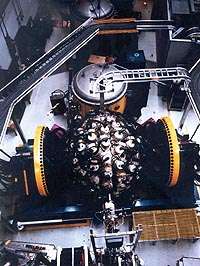Scientists take giant step forward in understanding exotic nuclei

Developing good predictive powers of how all nuclei work is critical to advance our understanding of the universe. The vast nuclear landscape, which is thought to consist of about 6,000 isotopes is not well charted and half the nuclei remain unknown.
Only about 300 isotopes are stable and exist in the world around us. A lot has been learned about these stable nuclei, but researchers at the U.S. Department of Energy's Argonne National Laboratory are developing techniques to uncover the secrets of some of the most unstable and exotic counterparts.
While the exotic isotopes are not normally present on earth, some of them play critical roles in the working of the stars, especially in the element-producing process of nucleosynthesis.
Darek Seweryniak and his colleagues from Argonne's Physics Division in collaboration with scientists from the University of Maryland, University of Notre Dame and University of Edinburgh, have focused their attention on a new isotope of tin, tin-100 (100Sn), one of the very rare "doubly-magic" nuclei. The doubly-magic assignment refers to the special cases where both protons and neutrons fill their quantum shells so that super-stability is achieved.
The properties of stable doubly-magic nuclei, such as oxygen-16 (16O), calcium-40 (40Ca) and lead-208 (208Pb) are well known, but the challenge is to determine the extent to which current models can be extrapolated to describe nuclei situated far from the line of stability, in this case, near the "proton dripline," where nuclear existence ends. Establishing the properties of this nucleus and its immediate neighbors builds a solid platform from which the properties of all proton-rich intermediate mass nuclei can be developed. To date, only a handful of 100Sn nuclei have ever been synthesized, in France and Germany, but almost nothing is known about its shell structure.
Using the Argonne Tandem Linac Accelerator System (ATLAS) facility in a 10-day experiment, the researchers started by synthesizing tin-101 (101Sn) and measuring its lowest excited state. 101Sn consists of a 100Sn core with the extra valence neutron orbiting in discreet quantum states in the field of the core.
Gamma rays emitted during the transition between these states were detected and analyzed in Gammasphere, the world's most powerful gamma-ray detector, and 101Sn nuclei were identified with the Fragment Mass Analyzer. The properties of the gamma rays reveal the sequence of states and their spacing, and can be used to directly challenge the reliability of contemporary nuclear models.
In the short term, the researchers expect to find further quantum states in 101Sn and learn more about the core this way. However, the experiment provides a key technical step toward the study of 100Sn itself in the future.
The detailed results of these findings were published in the journal Physical Review Letters in July. [Phys.Rev.Lett. 99, 022504 (2007)]
Source: Argonne National Laboratory




















